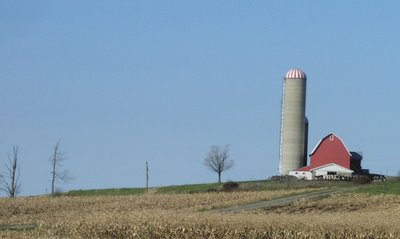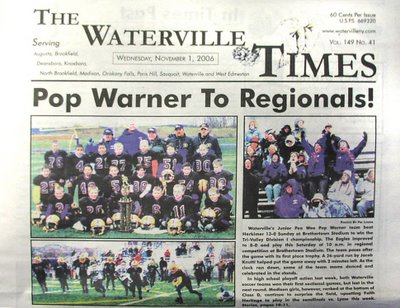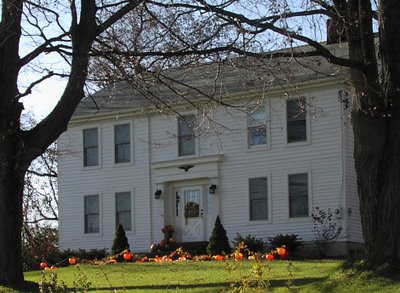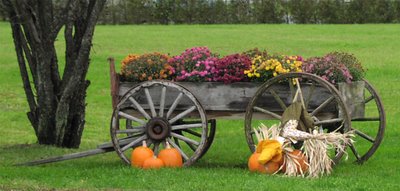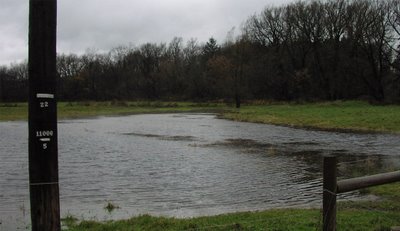
..... bright, but not very early!
At 7:00 it's 26 degrees and, according to the in-house weatherman, "clear and crisp!"
The Weather Channel is forecasting snow flurries, off and on, this morning, but right now the sky is blue and it's a perfect day for POP WARNER FOOTBALL at Brothertown Stadium at 10:00!
(Click to enlarge screensnap.)
I know that not everyone in the area will be going to the game. This is a big "early Christmas shopping" day, too, and the many will be heading for Clinton and the Annual Fine Arts & Crafts Sale which opens at 10:00. General admission is $3; Seniors $2, children under 12, free. Proceeds benefit the Clinton Central School District.
A few folks may even aim Northward, just to find snow! Here's the easy way to look at Winter: Old Forge has an excellent WebCam!
To check on the weather at Barnes Corners on the Tug Hill Plateau, click on the webcam at the Northern Chateau.
Saturday, November 04, 2006
Saturday morning,
Posted by
PsBrown
at
7:28 AM
![]()
![]()
Friday, November 03, 2006
Friday add-on
Lincoln-Davies and Morgan's Hardware have each probably sold a few snow shovels this morning! It has snowed off and on for several hours, but with very little accumulation to show for it. Trees and shrubs had the greatest amount of "frosting," especially the "Ditch Weed" along Route 12 South of Sangerfield.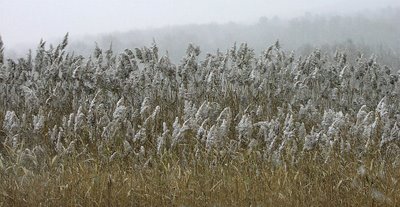
A tall North American reed having relative wide leaves and large plumelike panicles; widely distributed in moist areas and generally considered a nuisance! It does have its uses, however, which include: high quality warm-season forage and is readily eaten by cattle and horses. However, it becomes tough and unpalatable after maturity. Animals grazing this grass during winter should be fed a protein concentrate.
- Extensively used in Mediterranean region and elsewhere for building dwellings, lattices, fences, arrows by Indians, and for weaving mats and carrying nets.
- Young shoots sometimes used as a vegetable.
- The stalks exude a manna-like gum which is eaten. The rhizomes and roots also serve as emergency food.
- In Russia they are harvested and processed into starch.
- The reed is useful in the manufacture of pulps for rayon and paper.
- Pens for writing on parchment were cut and fashioned from this reed, and the
- stems were used as a linear measuring device.
- It can be processed into a fine fibrous material suitable as a filler in upholstery.
- Flowering stalks yield a fiber suitable for rope making.
- It is also used for thatching and for making partitions, fences, coarse mats, baskets, sandals, etc.
- Thin stems are made into pens; panicles are used for making brooms and for decoration.
According to Hartwell (1967–1971), the plant is used in folk remedies for condylomata, indurated breast, mammary carcinomata, and leukemia. Reported to be alexeteric, diaphoretic, diuretic, emetic, refrigerant, sialogogue, stomachic, and sudorific, the common reed is a folk remedy for abscesses, arthritis, bronchitis, cancer, cholera, cough, diabetes, dropsy, dysuria, fever, flux, gout, hematuria, hemorrhage, hiccup, jaundice, leukemia, lung, nausea, rheumatism, sores, stomach, thirst, and typhoid.
AND, finally ...... the Swiss use it in making bagpipes!
(There's such a great quantity of ditch weed right at hand that it's a shame we can't figure out some entirely new use for phragmites. For instance: no one mentions anything about being able to distill any part of the plant: are we missing an important opportunity for advancement, here?)

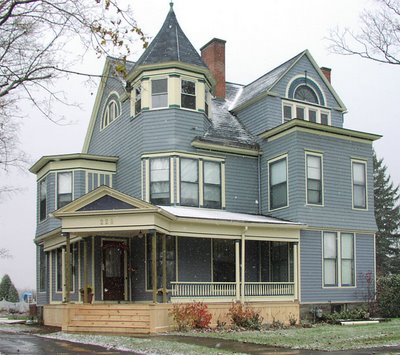
are finishing up just in time!
And - in case it was snowing so hard that you couldn't see the Bulletin Board in the Park, here's a closer look. (Click to enlarge photographs.)
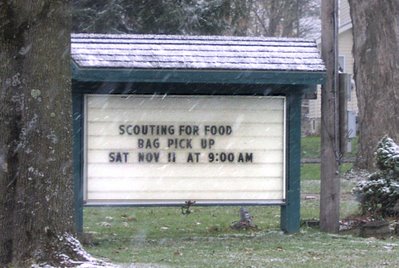
Looking back to July, just about four months ago! Alot has happened these last two years!


(I knew someone would ask!)
The first resident at "Hubbard's Corners" was Captain Simon Hubbard. He must have settled there in 1790 or 91 for it was at his house that, according to Pomroy Jones' 1851 "Annals of Oneida County, History of the Town of Sangerfield," "About the first of March, 1792, Minierva Hale and wife, and Nathan Gurney and wife and infant, moved into the town from New Hartford, where they had previously resided one or two years. The first day of their journey they reached the house of Simon Hubbard, who lived on the place now (1851) occupied by his son Marinus Hubbard, in the town of Marshall, where they remained over night."
Perhaps it wasn't a "corners," or junction, back than, but whenever Summit Road came in to use, probably as a primary road to and from the Sauquoit Valley, the term "Hubbard's Corners" made sense.
Miscellaneous bits from this week's "Social Notes and Items of Interest..."
Katie Peck has seen all-black caterpillars and old-timers say that there’s so much moisture in the soil we’re bound to have a lot of snow this Winter!
Folks in East Main Street wonder if the railings that are supposed to be installed next to the three new sets of stairs leading from the street to the sidewalk will be in place before slippery weather gets here.
The WCS Boys Varsity Soccer Team may have brought a somewhat passé haircut back into fashion: “the Mohawk” is now “in!” (Doubly “cool!”)
According to her daughter, Ms. LeeAnn Miller, Mrs. Shirley Spearing is making an excellent recovery from hip-replacement surgery and is currently in “rehab” at Hamilton.
The Keating Family, who usually tell us about their Summertime camping trips, only made two warm-weather ventures to the North Country and were met, each time, with rain. They are, however, having an enjoyable Autumn receiving frequent news from Ms. Chelsea Keating, who is studying in England!
Although we have not had a formal “report,” we believe that the ladies of the Crimson Bonnets were to have their monthly gathering - last Thursday - at the “Red Lobster.”
Members of the Waterville Garden Club will meet today (Wednesday, November 1st) at the home of the new club president, Bonnie Dobmeier, on Frog Park Road.
Bright posters are up advertising the St. Bernard’s annual Bazaar and Luncheon on Saturday, November 11th. Bazaar hours are 9:00 A.M. ‘til 3:00 P.M. and Lunch will be served from 11:30 until 2:00. We’ll be there!
And we’ll also be ready when The Waterville Women’s Club will hold one of their famous Bake Sales at Foodking on November 18th! (Perfect timing: stock the freezer with goodies for the holidays!) On the 21st, they’ll have “Harvest Tea” at “Hannah Leigh Antiques” and then reassemble at Village Hall at 7:00 in the evening for antiques appraisals. (Details will be forthcoming.)
No: that’s not a new furniture store on Main Street! Tommy Morgan has made arrangements to use the future “Subway” as an additional showroom, for the time-being. (I've tried to determine exactly what the status of "Subway" is, but get a frustratingly indefinite "On Hold, for now.")
Posted by
PsBrown
at
1:28 PM
![]()
![]()
Friday - finally!
It's just about 30 degees, this morning, and we look as if we'd been sprinkled with confectioner's sugar!
Lincoln Davies was ready to equip us for a "real" snowstorm: this wasn't it.
Nor, according to these Weather Channel predictions, shall we be doing any serious shovelling for a day or two, at least.
If you're yearning for the sight of snowbanks, watch some Webcams. Here's one near Turin.

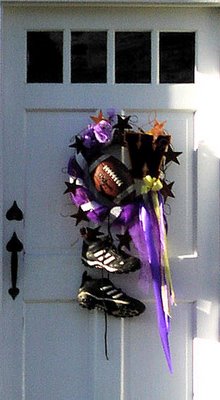

like just plain good Football Weather!

Their Red Raspberry Jam isn't as bright a red as my grandmother's "shoepeg" (Barberry) Jam but "shoepeg" was an appropriate name for the concoction: in the first place, whoever picked them had to deal with the thorns; the center seeds are HUGE and woody and, as I recall, the berry portion didn't have a particularly pleasing taste, so I'll stick to admiring red barberries on the branch!

Posted by
PsBrown
at
7:10 AM
![]()
![]()
Thursday, November 02, 2006
Reserve your tickets NOW!

The Waterville Historical Society's
ANNUAL Victorian Tea
will be held on
Saturday, December 9th
from 2 'til 4.
Guest speaker:
Marlene Minor,
"The Hat Lady"
A proper, three-course, Victorian Tea will be served. This year the
third course will feature a new selection of desserts. The recipes for
these delicious sweets are taken from the pages of the Society’s
cookbook.
Marlene Minor, “The Hat Lady,” will show her collection of bonnets. Her
presentation will be most interesting and all in attendance are
encouraged to wear a hat to add to the theme of the day.
Tickets for the Saturday afternoon Tea are $8.00 each; a table of six
is $42.00.Tickets are advance sale only as there is limited seating. No
tickets will be available at the door.
Reservations may be made by telephoning 841-4018.
The Victorian period began in 1837 when Victoria became Queen of England…she ruled until she died in 1901. Hers was the longest reign in English history. The Victorian period encompasses an extremely large array of hat styles from tiny little hats that perched on your head to large and elegant feather and flower laden hats. The utilization of flowers and feathers and even using whole birds became a near obsession with the hat designers and hat wearer of this period. The Victorian tea hats were followed by Edwardian Tea Hats and era that started in 1901 and ended in 1909 at the death of King Edward, son of Victoria.
Posted by
PsBrown
at
12:22 PM
![]()
![]()
"Daytonville" explained
Thank you, Wayne Brouillette!
An Abraham D. Eastman, who died on Febraury 25th in 1850 at the age of 81 years and 8 months is buried in the little Eastman "Pioneer" Cemetery. Possibly that is he. Ancestry.com has heaps of "Eastman" listings and Abraham Dayton is but one of two or three brothers who came here as pioneer settlers from Connecticut.
l
We also noted that at around 9 o'clock, yesterday morning , without fanfare or ceremony, South Stafford Avenue went into the history books and Barton Avenue became a real place.
Should North Stafford Avenue have the same fate as South Stafford Avenue, someday, we dug out the obituary of Major Aaron Stafford, for whom Stafford Avenue was named. (It's long, but those who are at all interested will probably be willing to spend the extra minute or two now, or come back to it later and will agree that his accomplishments were impressive.)
A VETERAN OFFICER OF 1812.
The Story of His Eventful Life - Rev. Dana Bigelow's Remarks - Long Life but a Point Compared With Eternity - His Coffin Enveloped in His Country's Flag.
Aaron Stafford of this village, was born March 18, 1787, and died the 6th of September, 1885. He was born and died on a Sunday; and was five months and twenty-nine days older than the federal constitution. He had resided in the town of Sangerfield 84 years, and lived 71 years in the house where he died. He was the last survivor of the soldiers of the war of 1812, who was known to have held an officer's commission; the last one before him having died about seven years ago. The first President he voted for was James Madison, and the last, Grover Cleveland. All the Presidents of the United States were inaugurated during his life time.
Mr. Stafford's funeral was attended from his late residence last Tuesday, and the services were performed by Rev. R.H. Nelson, Rector of Grace Church, and Rev. Dana W. Bigelow, pastor of the Memorial Presbyterian Church, of Utica. Mr. Bigelow ever since his boyhood had known Mr. Stafford personally, in whose character there was much that he admired. He delivered the following discourse on the occasion of his funeral:
But a few months since, a beloved grand-daughter, beautiful in youth, was borne from this house. Today, in the providence of God, we meet to bear to his last resting place the aged grandfather.
We had thought that Mr. Stafford might live to complete one hundred full years; and while he was enjoying a comfortable old age, in his own home, infirm but bright in mind, surrounded by those who ministered to his every want, we had earnestly hoped that this expectation might be realized. But an iron constitution yielded at last to bodily infirmities, and he who has been with this village from its settlement, and with this nation from before the day that its first President was inaugurated, has departed this life.
Can we speak of such life as a shadow? Yes, if we compare it with the life to come. We speak of this as long life, but a century has beginning and end, and the hereafter is eternity, the forever and ever. This measure of time is in truth but a point, and man at his best estate is as but a flower of the field. Our times are in the hands of One with whom a thousand years are as one day and one day as a thousand years. Shall we not then be again reminded that our days are as a shadow, and there is none abiding? Our days on earth are numbered, and though they be multiplied beyond those of any other person of our generation, yet they will be certainly and soon passed. Blessed be the Lord, our God, that He who has life and immortality, has given his own Son, that we may live by him. The Lord Jesus Christ is the resurrection and the life, and if on earth we live by faith in Him, in love and obedience, death is but the beginning of time and endless life. We may ask for the blessing of long life, and rejoice if many days are gven us on earth where we may find so much to do and so much to enjoy, but let it be our first and chief thought that under Divine guidance, in following Christ, we may be prepared for the Father's house in Heaven, for life in the presence of the glorified Saviour, and for reunion there with loved ones who have been redeemed unto God, to his own possession and joy, world without end. If, however, we compare on hundred years with the time allotted to nearly all of any generation, how remarkable they appear as the period of one individual life.
When the last century closed, a boy of thirteen years enjoyed a pleasant home across the street from this house where we meet this afternoon. All this part of the village was then the Stafford farm, a place for work, and the field for many sports, for boys of that day loved sport and knew where to find it, as did other boys who followed after in other years. Perhaps it was the memory of his own boyhood that made him so lenient when a man, toward boys who in generation after generation found a playground in his pastures and orchards, and by the stream that wound its was so pleasantly beneath the trees and through the fields of his wide reaching farm. We were never closely watched, never ordered off from the frequented fishing and swimming places, from croquet grounds and training fields. Surely his boyhood must have taught him, that boys are boys and that their sports last none too long.
When 1812 came Aaron Stafford was no longer a boy, but a young man, twenty-five years of age, and ardent lover of his nation, which was of his own age, nearly, not quite. He enlisted for war at the time of his country's need, and proved his valor and spirit of self-sacrifice in conflicts that left him severely wounded. Henceforth he bore in his body the marks of his participation. He gave other proofs of this regard for the welfare of his country. He served the State at one time in the halls of legislation; and when a private citizen, he maintained an intense interest in our history. If he differed from others in judgement at any time, none had reason to question the depth, or the sincerity of his convictions. He was unwavering in his loyalty to his friends. Those who once esteemed him as a friend, found him ever the same, cheerful in spirit and warm in personal friendship. His kindness of heart toward all, made him a man well spoken of and esteemed by tahe whole community. Those who remember his not as an aged man, shut in and ministered to, but the man of strength and of affairs, will expecially affirm the truth of these statements. Another generation has grown to manhood, since Mr. Stafford was very active among the leaders of society.
But in his own home he was best known. He had a worthy wife, who became a dearly loved mother. Children were born, grew to manhood and womanhood, went forth to take their places in the world, with fond memories of the old home, to which they love often to return. They remember him as a father ever thoughtful of their happiness, ever deeply interested in their welfare. Most affectionate, and most grateful for every act of kindness, he appreciated all that was done for his comfort in old age. He lived to witness how great changes were made in this village and this nation, and what overturnings in the world. He lived until his appointed time was come; and after bearing trials in brave and patient spirit, he has passed from among us. His peaceful and pleasant face nay now be looked upon for the last time.
The pall bearers were J.A. Berrill, W.J. Bissell, G.H. Church, M.L. Conger, J.W. Hubbard, E.H. Lamb, A.O. Osborn, Geo. Putnam, F.H. Terry and Charlemange Tower.
The remains were interred in the Waterville Cemetery, near the center of the grounds; he is the oldest person ever buried there. The stone over the grave of his father, Ichabod Stafford, whose grave is in the southwest corner is the oldest stone in the cemetery.
The following interesting sketch was prepared by Aaron Stafford's grandson, Martin H. Stafford of New York:
Aaron Stafford, born March 18, 1787 at Cheshire, Mass., and died at Waterville, N.Y., Sept. 6, at the advanced age of 98 years, 5 months and 18 days, was the second son of Ichabod Stafford by his wife Humility, daughter of James Green, Jr., of Coventry, R.I., and the lineal descendant of Thomas Stafford, one of the colony that settled at Portsmouth and Newport, R.I., in the spring of 1638.
At the close of the Revolution, in which he with four of his brothers had served their country, Ichabod Stafford, with his brother William, and their families, moved from Coventry, R.I., to Lanesboro, Mass., in 1783, and they were soon followed by his father and other members of the Stafford family, and it was here that Aaron Stafford was born soon after Lanesboro was divided and the new town of Cheshire created.
Ichabod Stafford removed to Duanesburgh, N.Y., in 1788, where he resided until the summer of 1793, when with Joseph and Abraham Forbes, with their families, removed to what is now August, Oneida Co., N.Y., being the first white settlers of that town. In 1801 Mr. Stafford having purchased of Nathan Gurney, Bazerial Gurney, his son, and Bincas Owen, all their rights in lot No. 40, in the town of Sangerfield, and what is now the eastern portion of the village of Waterville, removed his family to his new home, and in the following year built a house upon the lot where now stands the residence of Mr. George Putnam. Here Mr. Stafford lived until his death, July 30, 1804. At his death he left a widow and a family of five chi in a new, but rappidly growing country, he had few of the advantages enjoyed by those who were members of older communities, but he improved the advantages that were presented, and few indeed were the boys of his time who could equal him in natural abilities, or who had improved their advantages better than he. At the death of his father he took the most active part in the management of the property that his father had left, at the same time not neglecting to improve his mind.
In 1801 his mother and the other children, of which Aaron Stafford was the third and then in his eighteenth year. Mr. Stafford left his family in comfortable circumstances and the farm was managed for several years by his widow, in which she was assisted by her two eldest sons, but Aaron in particular.
The early years of Aaron Stafford's life were passed much as the life of any boy in his station of life may be supposed to have been passed, without any particular event to distinguish it from those of his companions. The son of a pioneer the other children moved from the house his father had built to a new house they had erected on the opposite side of the road, and Mr. Stafford opened the old home as a public house, which he conducted successfully for two years, but the life was not in many respects pleasant to him and he closed it to devote his time to farming.
Mr. Stafford was engaged in farming when the war of 1812 called the country to arms. He was the first to enlist and call upon the young men of the vicinity to join him. He raised a small company of men, of which he was appointed ensign, and in May, 1812, went to Sacketts Harbor under Col. Marshall Bellinger in First Detachment N.Y. State Militia. When the three months had expired for which they had volunteered, he volunteered to remain and was in service twenty-four days before discharged, the service having been one of garrison duty.
Immediately on his return home he was visited by Major Maynard who, appreciating his ability and courage, offered him the position of adjutant of the 16th Reg. N.Y. Detached Militia commanded by Lieut. Col. Farrand Stranahan. He accepted and at once went to Albany, where he successfully passed the examination and received his commission. After procuring his uniform he joined his regiment at Winfield on Sept. 8, 1812, and the regiment soon after took up its march for the Niagara River and reached Niagara Falls the Friday before the battle of Queenstown Hights. He was soon after dispatched with a company to Buffalo to convey provisions to the army, and executed his difficult commission with so much skill and dispatch as to win the applause of his superior officers.
At sunrise on the morning of October 13, 1812, the main body of the army, under the command of Gen. Winfield Scott, commenced to cross the river, and Stafford was left in command of a detachment to cross after the main body had landed. He followed close after the main body, under fire of the British, landed and commenced to ascend the hights, but had not proceeded but a short distance before they were fired upon by a body of British and Indians, by which several were killed and wounded. Stafford was shot in the shoulder by an Indian, but still kept his horse and passed on at the head of his command, but was soon again shot in the thigh and fell from his horse. Several officers and men who saw him fall supposed him dead, but rushed to the spot to prevent him from being scalped by the Indians, among the number Capt. Felt, who helped to bind up his wounds and assisted to carry him down the hill. but the Americans had lost the day, being outnumbered, and all the wounded, with many others, were taken prisoners. Stafford, with many of the officers and men, were conducted to Ft. George, where they were confined as prisoners of war. Stafford's wounds proved severe and he suffered greatly from want of proper care and attenion, though Dr. Sumner, the British surgeon in charge, did all he could under the circumstances to alleviate the sufferings of those under his care, but particularly of Stafford, who he admired for his high spirit and patient endurance of his wounds, and here was the commencement of a warm personal friendship between them which was only broken by the death of Dr. Sumner many years after.
Stafford, with other officers and men, were paroled after a week's imprisonment, and Dec. 8 he hired a boat to take him across the Niagara River to Black Rock, but nearly lost his life through the blundering of the men who rowed the boat. After a long and painful journey he reached home on Christmas night in a very exhausted state of health, and weeks passed before he was even out of danger.
This terminated his military career, and though promoted to the rank of Major he did not recover from his wounds sufficiently to permit him to again enter the service until the war was over, much to his sorrow, as the martial spirit ran high in his character.
June 26, 1814, he married Harriet, daughter of Zeno Terry, who moved from Enfield, Conn., to Sangerfield, N.Y., being one of the first settlers of that town. He commenced his married life in the house which he had previously purchased from his brother Welcome, which he considerably enlarged and improved and made his residence the remainder of his life. Here he lived in great happiness with his wife for sixty-one years, until her death, April 5, 1875, and here their children were born. Lothrop P.; Mary, wife of Henry T. Utley of Waterville, N.Y.; Harriet, wife of William B. Stafford of New York; Marshall B., and Aaron Jackson. The eldest and youngest died several years before him.
Mr. Stafford was an active man in the community in which he lived, interesting himself in all measures for the advancement and improvement of the town, and though an active member of his political party, labored for its success from principles and not for political advancements. He was repeatedly urged to accept office, but only consented to the use of his name but once. That was in 1833, when the Democrats were very anxious to elect their legislative ticket in his District. The district had become close, and it was generally supposed that the Whigs would win it. Members of the legislature were elected on a general ticket at the time, and not by single districts, as at present, and Mr. Stafford was urged to gon on the ticket to strengthen it, as he was personally very popular with all classes. He accepted the nomination and the ticket was elected, greatly to the surprise of the Whig candidates, who felt so confident of their election that they had engaged their quarters at Albany in anticipation of their sure eleection. Mr. Stafford acquired considerable reputation for the share he had in the victory. Judge Pomeroy Jones of Westmoreland was associated with Mr. Stafford on this legislative ticket and was also elected. A long and sincere friendship existed between them, severed only by the death of Judge Jones about two years ago. Political life had no charms for him, and he took greater pleasure in contributing to a victory than being the recipient ofits fruits.
Mr. Stafford was a farmer, his whole active life being devoted to the cultivation of the soil, in which occupation he was successful, and his farm was one of the largest and best conducted in this section of the country. He and his brothers and sisters owned at one time all the land upon which the eastern portion of the village of Waterville is situated. Both sides of what is now Stafford avenue as far as the old Hooker road was once his farm and where are those yet living who can remember when there were very few houses on that avenue, except the house in which he lived and died, which was built in 1810 by his brother, and purchased by him in 1813, and which has undergone so many changes as to leave but little of the original design recognizable. It was here that he had lived for seventy-one years and died, and all his children were born. He had lived to see a prosperous and beautiful village grow up out of the wilderness, and be surrounded by more people than were to be found in the whole county when he came to it as a boy, for indeed there was no such county as Oneida then, or for several years after. Not a person is now living who remembers him as a boy, or young man; they have all passed away, and like the tall oak that has been spared by the woodman and stands alone, so stood he - the last survivor of the little colony in the wilderness, surrounded by a new generation and a new life. He was not only the oldest person in the town at the time of his death, but the oldest citizen, not only of this town but of any in this section of the state. That is, there is no one known to be living in the county of Oneida, or of Central New York, who came to it as early as he - 1793. He was also the last survivor of the soldiers of 1812 who was known to have held an officer's commission.
In person Mr. Stafford was five feet ten inches in height, of commanding figure, and like his father's family, possessed of great physical strength. In his younger days he carried himself erect, with dignified bearing, and was regarded as a man of prepossessing appearance. Amiable in disposition, of even temper, and proverbial for his kindness of heart, strict integrity and unimpeachable honor, he commanded the respect of all with whom he came in contact. He was very firm in his convictions and bold in expressing his opinions, which were never formed hastily, but after due reflection, and when once formed he held to them with great pertinacity. Deprived of the advantages of an early thorough education beyond what was furnished by the new country in which he lived, he endeavored to repair the deficiency by extensive reading, and few men were better informed, or could converse more intelligently on all subjects of general interest than he. His memory was remarkable, and it was astonishing even in the later years of his life to note with what accuracy he could relate events, accompanied by dates, which one would hardly suppose would have been remembered. Nothing that he had ever seen, heard or read, appears to have been forgotton or worn outof mind. This tenacious memory he inherited from his mother, who was quite as remarkable in this respect as himself. He might truly be said to have been a walking encyclodaedia of events during his life, and many were the disputed questions among his townsmen that were referred to him for decision, and the verdict accepted without dispute. He was never so happy as when entertaining his friends with reminiscences of the past or in conversing on favorite themes. Had Mr. Staffod inclined to public-life, his great popularity, energy and strength of character, combined with a tenacious memory, would have given him great advantages and placed him in high positons, but his modesty was quite equal to his other merits, while his ambtion appears to have flown in other channels.
Posted by
PsBrown
at
7:51 AM
![]()
![]()
Thursday
Sharon Stiles gives us a Morning Smile in her
Fingernail Corner at the "Totally-U" Salon on Main Street!!!
It's drippy out, again. (The cows WERE right!) 36 degrees on the nose, and it looks as if our days of Indian Summer are over.
Two truths, often discussed:
- We must be very wasteful to need two garbage pickups every week!
- We're very lucky that the Village of Waterville provides two garbage pickups every week!

Headlines from the front page of this week's edition of the Waterville Times:
"Pop Warner to Regionals!" - Color pix and coverage of Waterville's Junion PeeWee Pop Warner team's Tri-Valley Division I championship.
"Sangerfield Meets Nov. 6." - Town Board will meet Monday, Nov. 6 at 7:00 P.M. for preliminary budget hearing.
"Lachut Case Adjourned" - Andrew Lachut's next court apperance will be a pre-trial conference on December 28.
"WCS Wants Healthy Students" - The district's Health and Wellness coordinator, Tammy Alcott, emphasises the importance of halting childhood obesity and improving students' overall health.
"Pataki Picks Brennan" - Patrick H. Brennan of Deansboro, New York State Agriculture Commissioner, will chair SUNYIT College Council.
"Three Months Missing" - Information is still being sought in re: the July 30 disappearance of Michelle Hutchings, 27, of Marshall.
Glenn Scobey Warner (April 5, 1871–September 7, 1954) was an American football coach, also known as Pop* Warner. During his 44-year career as a head coach (1895–1938), Warner had 319 major NCAA college football wins. He also helped start the popular youth American football organization, Pop Warner Little Scholars. (*When he started to play football, he was older than his teamates!)
When Pop Warner first played and coached, football was played under crude rules and conditions. The 1905 season alone resulted in 15 fatalities and the sport was almost outlawed. Football historians credit Warner with being in the forefront of the movement which transformed the game from one of brawn to one of skill. He developed the crouching stance, the body block, the spiral forward pass and punt, the single and double wing offenses, all of which have survived to the present. He also experimented with safety equipment and, at Pittsburgh, introduced the numbering of players, where, it is said, the expression "You can't tell the players without a program" originated. Still in the vanguard of new ideas in 1932, Pop Warner was among a handful of coaches who pressed for legislation of the free forward pass from anywhere behind the line of scrimmage, a rule adopted by the professionals a year later, which multiplied the offensive possibilities of the game. His interest in a player did not begin and end with the football season. A strong believer in the value of an education and the development of a well-rounded individual through athletic competition, Warner expected and received no less from his players in the classroom than he did on the playing field. Scores of boys became men under his tutelage and went on to careers as distinguished as they were varied. Thus, it is for many reasons that a junior league football player program carries on his name.
lll
At Michael's on Saturday evening at 10:00 P.M.
Halloween Costume Party!
$5 per person; 80's dance mix with The RetroPolitans.
Driving southbound from New Hartford over Paris Hill, on Monday afternoon, we decided to take Daytonville Road, which runs from just south of Paris green to a bit north of the Village of Waterville. Reaching the little cluster of community that we have always presumed was the original "Daytonville," one or the other of us wondered, "Who was Dayton?" We've since then looked through the 1851 history of the Town of Marshall, by Pomroy Jones and searched both the 1852 and 1874 maps and can't find anyone with that name nor is there a "Dayton" in the 1869 Oneida County Directory! The only reference at all was one "hit" on the Oneida County GenWeb site: "Margaret Bradley of Daytonville, d. May, 1879."

Posted by
PsBrown
at
5:18 AM
![]()
![]()
Wednesday, November 01, 2006
And MORE!!
Rick Garrett went to the trouble of tracking me down in Foodking, on Saturday, to tell me that
"The Deal is Off!"
and that
"Foodking is no longer on the market!"
It's a good sign!
Two gentlemen from Advanced Power & Light Electrical Contracting were out and around on Main Street, this morning, rifling through sheafs of plans and contemplating lamp bases. Dennis Jones, president of the company, said that indeed they expected the lamps "by the end of this month." He offered, "It'll look nice for the holidays!" and when I said I hoped that wintery weather wouldn't cause too much delay of installation, he grinned and said, "We're like the mailmen: 'neither rain nor sleet, nor.......' " So: things certainly are looking brighter!!
Not such a good sign? The Gallaghers' cows and the Brouillette cows were in agreement, earlier this afternoon. (WKTV News Channel 2 weather also forecast showers.)


R.F.B. saw Mr. Roger Gates, of Clinton, this morning, and phoned home with this news:
take your camera to Skyline Drive in the vicinity of Reservoir Road.
A rare treat is in store, for that's when the horn will sound, the hounds will be loosed,
and scores of brightly-jacketed riders on magnificent horses will be off,
racing across the fields after them.
To put a HUGELY bright SMILE
on someone's face, tomorrow morning,
wish Ann Ingersoll a
HAPPY BIRTHDAY!!
Posted by
PsBrown
at
1:36 PM
![]()
![]()
Wednesday Add-ons!
John Savage has sent me the Pop Warner PeeWee Play Off Schedule:
it all begins on Saturday, at 10:00 A.M.!
 (Click to enlarge!)
(Click to enlarge!)
the Oz Family would have visited us. They sent a photograph, instead!
Wearing their usual "costumes" - hard hats and safety vests - and carrying their usual props - surveying equipment and walkie-talkies - a D.O.T. crew is making a "Final" survey of the Rt. 12 Highway Reconstruction Project --- a step in declaring that it is entirely finished. The only place where any work at all is in progress is in what used to be the deep ravine behind homes on the southeasterly side of Sanger Avenue, where all of the old pavement was dumped. Property-owners were promised that their back yards would all be nicely terraced and finished off: no one has complained, so far!
Perhaps someone would send a photograph of that work for blog-readers to see?
And I'm hoping that sometime today some photographs will arrive from Hobie and Lois Morris taken, very recently, of a black bear that has been making himself at home around their Quaker Hill residence! He's investigated their cold-storage bins and given their truck a good look-see, but has done no damage, so far!
Posted by
PsBrown
at
7:04 AM
![]()
![]()
Wednesday
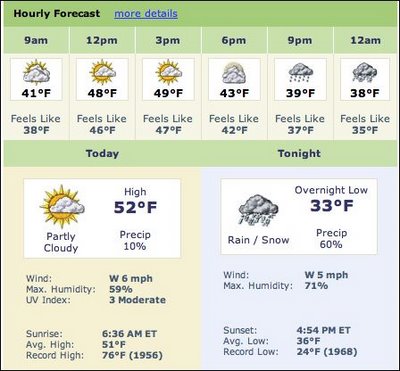
It was mild out, last evening, and 'though there was a light rain the spirits of our costumed visitors and their parents were bright. Being somewhat "off the beaten path," or, in this case, the Candy Trail, our doorbell rang far less frequently than those up in the village.
Recognizable despite disguises......


Posted by
PsBrown
at
7:00 AM
![]()
![]()
Tuesday, October 31, 2006
Tuesday afternoon
There are several websites devoted to Hallowe'en (or "Halloween") myths and legends. If you want to know more about Bats and Broomsticks, click here!
If you didn't happen to catch "Mohawk Valley Living" host Richard Enders splashing up the road to Tassel Hill, last Sunday morning, just go to the link that says "Watch Video" and have a chuckle! Richard warns viewers that you simply can NOT reach the top of the hill without a mud-loving 4-wheel-drive vehicle. We suspect that in drier years in times past the summit was a favorite spot for Hallowe'en gatherings. (Now don't blame ME if you get stuck!)
I remember the late Stephen Gates telling me that the fir trees were planted in a manner so to spell out "Tassell Hill" - with two "L"s on Tassell. Are there any readers who remember when that was done? and by whom? (The "C.C.C" - Civilian Conservation Corps rings a bell.) And is there anything more to be known about the name "Tassell Hill" than that - according to the history of the Town of Paris - it was named for an early settler, a Dutchman named Van Tassel (with one "L".)
Posted by
PsBrown
at
4:00 PM
![]()
![]()
It's Hallowe'en!
It's a different story, up North, where they're still digging out, but here in Waterville
'tho some showers are forecast for later on.


The only collection today will be that of TREATS, tonight between 5:00 and 7:00!
There are a great many "histories" of Halloween on the internet. I like this page by PumpkinMaster.com. who also provides the following history of the "Jack o Lantern" - which I didn't know.
"The word Jack O Lantern was 1st used to describe a mysterious light seen at night flickering over marshes. When approached, it advances, always out of reach. The phenomenon is also known as will o the wisp and ignis fatuus (foolish fire). In pop legend it is considered ominous and is often thought to be the soul of one who has been rejected by hell carrying its own hell coal on its wanderings.
In Ireland, where Halloween began, the first jack-o'-lanterns weren't made of pumpkins. They were made out of rutabagas, potatoes, turnips, or even beets! There is an old Irish legend about a man named Stingy Jack who was too mean to get into heaven and had played too many tricks on the devil to go to hell. When he died, he had to walk the earth, carrying a lantern made out of a turnip with a burning coal inside. Stingy Jack became known as "Jack of the Lantern," or "Jack-o'-Lantern."
From this legend came the Irish tradition of placing jack-o'-lanterns made of turnips and other vegetables in windows or by doors on Halloween. The jack-o'-lanterns are meant to scare away Stingy Jack and all the other spirits that are said to walk the earth on that night. It wasn't until the tradition was brought to the United States by immigrants that pumpkins were used for jack-o'-lanterns."

And it wan't until Peter, Paul & Mary recorded it - a LONG time ago - that I'd ever heard the "Souling Song," which we should all sing tomorrow for "All Souls" - (November 1)!
I sent a "Cheers!" note to Pop Warner Head Coach John Savage, praising all the "kids" and thanking him for all time and energy he devotes to the boys, and he wrote back saying "My job is easy: I have a great group of coaches! - Bob Piersma, Jay Hemmeric, Shaun Harry & Mark Evans." (From my advanced chronological perspective, they are ALL a great bunch of "kids!")
John will let us know when the next game is scheduled.
R.F.B. Thanks those who sent him E-greetings, yesterday!
From a few conversations, yesterday, I gather that I'm not the only person who has trouble adjusting to "falling back!" And those whose households or barnyards include four-legged friends - not to discriminate against two-legged fowl - are simply not allowed to adjust easily because animals in general, and roosters in particular, simply do NOT approve of the practise of tinkering with their schedules no matter how reasonable a human tries to make it sound!
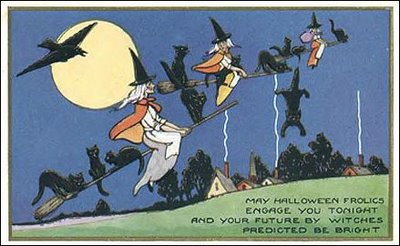
Posted by
PsBrown
at
5:02 AM
![]()
![]()
Monday, October 30, 2006
Pop Warner Report
Waterville did indeed "Beat Herk"!
13 - 0!!!
Posted by
PsBrown
at
7:37 AM
![]()
![]()
Another Monday
It's a good thing that the wind that we had yesterday has died down or there would be trash containers - or containerless trash - flying and rolling all over the village!

The wind brought down some wires on Route 20; medium-sized branches fell, here and there, and that solitary silo near California Road tilted and, finally, fell.

I still havn't received any word on the scores of yesterday's Pop Warner games at Brothertown Stadium, but I do know that the Annual Waterville Rotary Halloween Party that took place at Memorial Park School last Thursday evening was a great success. The children, age pre-K to grade 5, enjoyed a costume parade and dance, as well as a variety of games and activities. Cider and donut holes were served to all and each child took home a Halloween goodie bag, as well.
Ms. Machold says that 450 people were served at the Deansboro Congregational United Church of Christ's Turkey Supper on Saturday!
.. and at least two people will be eating out again, today: my treat!
(click the link)
!
Posted by
PsBrown
at
5:12 AM
![]()
![]()
Sunday, October 29, 2006
Sunday morning Add-ons
In the blogger's early mail was a note from Kraig Pritts! One of his former students had told him where to find "At Home in the Huddle" and he's bookmarked the site and has been checking up to see what's been going on here!
At just a minute or two before 9 o'clock, the parkinglots outside Brothertown Stadium were nearly full. Fans were wrapping themselves in extra coats and scarves because the sky was gray and the wind very strong and gusty. It was just a bit above freezing and at least it wasn't raining or snowing!!!
Not very good weather for outdoor activities in general, but the coloring added contrast to a few photographs:
 Tamaracks - or Larches, depending on what part of the country you're from - shining gold in the
Tamaracks - or Larches, depending on what part of the country you're from - shining gold in the swampy area across from St. Bernard's Cemetery on Tower Street.
Posted by
PsBrown
at
9:31 AM
![]()
![]()
Sunday morning!
Did you remember to reset your time pieces and "fall back" an hour?
35.6 degrees; windy, but there is no precipitation of any sort, right now.

Yesterday could not have been more wet! We drove eastward to rendezvous at the Palatine Bridge Pizza Hut with our daughter Allison and her husband Rick and our grandson, eight-year-old Iain, who had his Jedi Padawan costume - made by his very clever mother! - to show us.
(The Writer hesitated before including a picture of Iain, but is reminded by a very proud grandfather that it is, after all, her blog and she can do as she pleases!)
Quite a number of the farms in the countryside near Palatine Bridge are owned by Amish families. On such miserably cold, wet days, especially, we not only admire them for their adherance to a strict - and restrictive - lifestyle, but also wish that we had a much larger vehicle that we might offer them and their horse a dry ride to their home and barn.
It was still raining when we came back to Waterville: water in a field pond on Hanover Road was lapping the edges of the pavement; a "wet spot" in a field next to Osborn Avenue was at least double its normal size and "Lake Sangerfield," had it not been right next to the highway, would have made a fine landing site for Canada Geese. The one spot that was NOT at all flooded was the underpass!!
Posted by
PsBrown
at
4:57 AM
![]()
![]()

